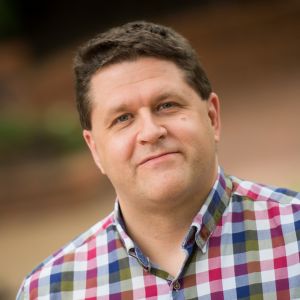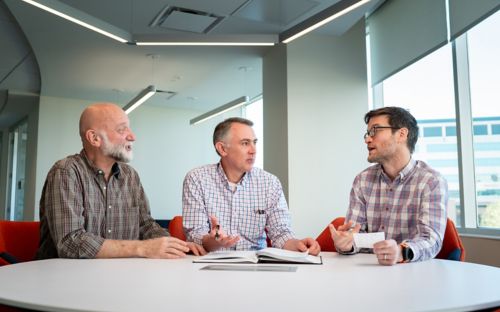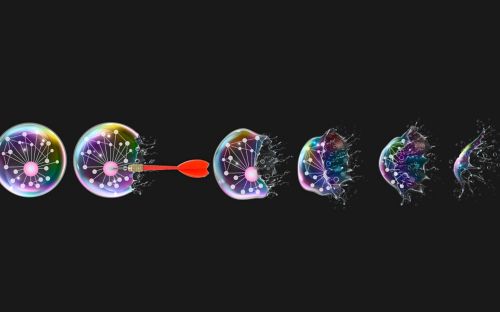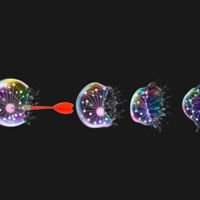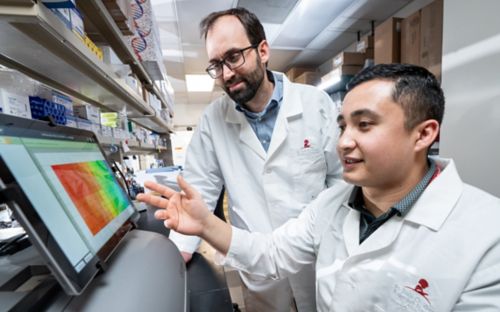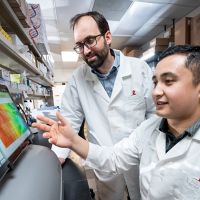New clues about the machinery of brain development
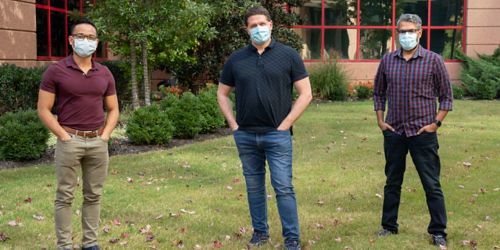
Research in the lab of David Solecki, PhD, center, reveals possible treatment targets for childhood brain cancer. Also pictured are Niraj Trivedi, right, and Taren Ong, PhD, left.
A central question we explore in our lab in the St. Jude Department of Developmental Neurobiology is how the brain develops. We are constantly discovering insights that shed light on the fundamental nature of brain development. We’re also looking for potential molecular targets for treatment strategies that exploit the abnormal biological machinery of childhood brain cancer.
Two key things for a developing brain
In order for the brain to form its neural circuitry during development, two things have to happen. First, the brain has to form the right amount of neurons. If you are building a computer and you don’t have enough chips, your computer is not going to work. It’s the same with the brain.
The second thing that must happen—and the other key question our lab explores—is the logistical challenge of how neurons get to their destination and form the brain’s circuitry.
When neurons are born in the brain, they are actually born a distance away from where they eventually need to be in the functioning neural circuitry. The brain needs those neurons to move from their birthplace, called the germinal zone, to their final position.
Our latest discovery has given us important information on the mechanism by which the immature neurons know to stop proliferating and begin to mature, or differentiate, and move to their final position.
The study, newly published in the journal Nature Communications, was carried out by postdoctoral fellow Taren Ong, PhD, in my laboratory and his colleagues.
Siah2 has a dual role
We had been studying the role in brain development of a protein called Siah2. We knew it was a timekeeper for germinal zone exit, involved in the decision of immature neurons to leave the germinal zone. We also knew that Siah2 is a type of enzyme that tags proteins with a molecule that marks them for recycling.
In a beautiful set of experiments with developing mouse neurons, Taren and our team showed that Siah2 is more than just a timer, but an enforcer of germinal zone occupancy. The protein is a key regulator that links the machinery of cell proliferation with the machinery that drives the immature neurons to exit the germinal zone and begin their journey to their ultimate functioning position.
Siah2 continually degrades and keeps in check proteins that cause neurons to retract a structure on their surface called a cilium. Cilium function like an antenna, receiving biochemical signals from outside neurons. The signals drive the neuron to proliferate. When it’s time for the neuron to mature, the cell’s machinery switches off Siah2, freeing proteins that cause the neuron to retract its antenna. Without the proliferation signals, the neuron matures, or differentiates, and leaves the germinal zone.
The experiments revealed this surprising interplay of proteins that engage each other in a tug-of-war that regulates whether the cells leave the germinal zone or not.
Another surprise protein
A second surprise was the identity of one of the cilia-destroying proteins in this tug of war. Called Pard3, this protein promotes retraction of the cilia when not kept in check by Siah2.
These findings have considerable significance not only for understanding the developing brain, but in understanding brain and other cancers. The most common malignant childhood brain cancer is medulloblastoma. Medulloblastoma is diagnosed in several hundred children each year in the U.S. A hallmark of a major subtype of medulloblastoma, sonic hedgehog (SHH) medulloblastoma, is overproduction of Siah2.
Nature’s medulloblastoma hint
Nature has given us a huge hint that this mechanism is a good place to understand what goes wrong in medulloblastoma and develop effective therapies.
When experiments inhibited Siah2 in mice engineered to have the biological characteristics of Shh-medulloblastoma, it restored normal function. In fact, other researchers are developing drugs that inhibit Siah2. These could lead to promising new treatments for this medulloblastoma subtype.
